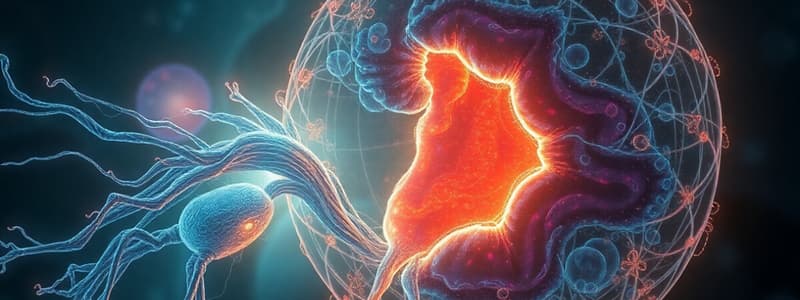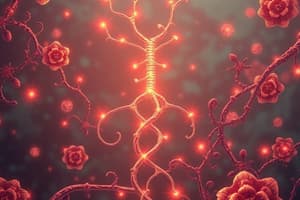Podcast
Questions and Answers
What type of cell is considered totipotent during the initial stages of development?
What type of cell is considered totipotent during the initial stages of development?
- Trophoblast cell
- Neural tube cell
- Embryonic stem cell
- Zygote (correct)
At what developmental stage do blastomeres become pluripotent?
At what developmental stage do blastomeres become pluripotent?
- At the 4-cell stage
- As the embryo approaches blastulation (correct)
- At neural tube closure
- At the 8-cell stage
What does the term multipotent refer to in the context of cellular development?
What does the term multipotent refer to in the context of cellular development?
- Ability to generate multiple cell types within a restricted lineage (correct)
- Ability to produce any cell type
- Capacity to give rise only to extraembryonic cells
- Able to form only one specific cell type
What occurs to trophoblast cells as the embryo nears the blastocyst stage?
What occurs to trophoblast cells as the embryo nears the blastocyst stage?
Which cellular mechanism does NOT drive proper embryonic growth and patterning?
Which cellular mechanism does NOT drive proper embryonic growth and patterning?
What is the primary characteristic that distinguishes unipotent cells?
What is the primary characteristic that distinguishes unipotent cells?
During which stage has the fate of individual embryonic cells become highly restricted?
During which stage has the fate of individual embryonic cells become highly restricted?
What is the significance of asymmetrical cell division in embryonic development?
What is the significance of asymmetrical cell division in embryonic development?
What is the process by which one allele is expressed while the other is silenced in genomic imprinting?
What is the process by which one allele is expressed while the other is silenced in genomic imprinting?
What is formed as a result of X chromosome inactivation in females?
What is formed as a result of X chromosome inactivation in females?
Which gene is crucial for initiating X chromosome inactivation?
Which gene is crucial for initiating X chromosome inactivation?
In the context of genomic imprinting, when the paternal allele is methylated, what occurs?
In the context of genomic imprinting, when the paternal allele is methylated, what occurs?
Which of the following best describes how tissue-specific gene expression arises during development?
Which of the following best describes how tissue-specific gene expression arises during development?
How does X chromosome inactivation occur in XX individuals?
How does X chromosome inactivation occur in XX individuals?
What happens during the X inactivation process at the chromatin level?
What happens during the X inactivation process at the chromatin level?
What implication does having two X chromosomes have on X-linked inheritance?
What implication does having two X chromosomes have on X-linked inheritance?
What type of signaling involves factors that act on the same cell from which they are secreted?
What type of signaling involves factors that act on the same cell from which they are secreted?
Which of the following accurately describes paracrine signals?
Which of the following accurately describes paracrine signals?
What role do morphogens play in embryonic development?
What role do morphogens play in embryonic development?
In the context of inductive signaling, what does the term 'reciprocal' interaction imply?
In the context of inductive signaling, what does the term 'reciprocal' interaction imply?
How are morphogen gradients influenced in addition to diffusion?
How are morphogen gradients influenced in addition to diffusion?
What is the primary characteristic of juxtacrine signaling?
What is the primary characteristic of juxtacrine signaling?
What is the significance of overlapping morphogen gradients?
What is the significance of overlapping morphogen gradients?
During vertebrate eye development, which structure induces lens formation?
During vertebrate eye development, which structure induces lens formation?
What process refers to the separation of neural crest cells from the epithelium during development?
What process refers to the separation of neural crest cells from the epithelium during development?
Which of the following cell types is NOT derived from neural crest cells?
Which of the following cell types is NOT derived from neural crest cells?
What key role does apoptosis play during mammalian development?
What key role does apoptosis play during mammalian development?
What drives the migration of neural crest cells during development?
What drives the migration of neural crest cells during development?
During which developmental process does apoptosis occur to separate digits in mammals?
During which developmental process does apoptosis occur to separate digits in mammals?
What function do BMP and Wnt morphogens serve in neural tube development?
What function do BMP and Wnt morphogens serve in neural tube development?
What is the result of high levels of Shh secretion in the neural tube?
What is the result of high levels of Shh secretion in the neural tube?
Which signaling pathway is primarily involved in lateral inhibition during cell differentiation?
Which signaling pathway is primarily involved in lateral inhibition during cell differentiation?
What is a characteristic of juxtacrine signaling?
What is a characteristic of juxtacrine signaling?
During which developmental stage does the migration of cells to specific locations predominantly occur?
During which developmental stage does the migration of cells to specific locations predominantly occur?
How do migrating cells respond to their environment during development?
How do migrating cells respond to their environment during development?
What is the effect of the first cell to engage the Notch pathway in adjacent progenitor cells?
What is the effect of the first cell to engage the Notch pathway in adjacent progenitor cells?
Which of the following describes the role of Notch in lateral inhibition?
Which of the following describes the role of Notch in lateral inhibition?
Flashcards are hidden until you start studying
Study Notes
Cellular Mechanisms of Development
- Mammalian development begins with a single cell, the zygote, which gives rise to all tissue types and organs
- Development is highly regulated in both space and time
- Cellular mechanisms including asymmetrical cell division, cell signaling and migration, differential gene expression, and programmed cell death drive embryonic patterning and growth
Cell Potency and Specialization
- Totipotent: a single-celled zygote can give rise to every cell type, both embryonic and extraembryonic
- Pluripotent: Asymmetrical cell division restricts blastomeres to either embryonic or extraembryonic cell types, but not both
- Multipotent: Cells can generate multiple cell types within a restricted population or lineage (e.g., ectodermal cells: neural, epidermal, and neural crest)
- Unipotent: Cells generate only one cell type
Genomic Imprinting
- Specific alleles can retain methyl groups, leading to parent-specific gene expression in offspring
- Paternal allele imprinting (methylation) results in gene expression only from the maternal allele, and vice versa
X Chromosome Inactivation
- XX individuals have twice as many copies of X chromosome genes as XY individuals
- One X chromosome in each cell becomes inactivated early in embryonic development due to the expression of the XIST gene, resulting in chromatin remodeling, DNA methylation, and gene silencing
- X chromosome inactivation occurs randomly in each embryonic cell
Tissue Specific Gene Expression
- Tissue-specific gene expression arises from unique combinations of transcription factors expressed in individual cells
- Enhancer sequences outside of DNA coding regions can modulate gene expression levels
Inductive Cell Signaling
- Inductive interactions between cells can influence differentiation
- Paracrine: Secreted signals affect nearby cells via diffusion
- Autocrine: Signals affect the same cell that secreted them
- Juxtacrine: Cell surface ligands interact with receptors on adjacent cells
Morphogens
- Inductive paracrine factors that form concentration gradients in tissues
- Morphogen concentration influences the fate of receiving (competent) cells
Notch Signaling
- Notch receptor protein in an inducing cell membrane interacts with a ligand (e.g., Delta) in the receiving cell membrane
- Notch signaling can induce differentiation in one progenitor cell while keeping the other undifferentiated (lateral inhibition)
Cell Migration
- Key for embryonic development and morphogenesis
- Cells migrate in response to external (environmental) and internal (cell adhesion) factors
Programmed Cell Death (Apoptosis)
- Important for restricting cell numbers during development
- Apoptosis occurs to:
- shape tubular structures
- separate digits
- eliminate excess cells
- During limb development, apoptosis of interdigital webbing separates the limb bud into digits
Studying That Suits You
Use AI to generate personalized quizzes and flashcards to suit your learning preferences.




